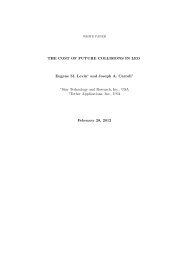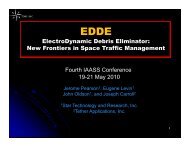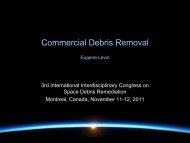Affordable Debris Removal and Collection in LEO - Star Technology ...
Affordable Debris Removal and Collection in LEO - Star Technology ...
Affordable Debris Removal and Collection in LEO - Star Technology ...
Create successful ePaper yourself
Turn your PDF publications into a flip-book with our unique Google optimized e-Paper software.
63 rd International Astronautical Congress, Naples, Italy. Copyright ©2012 by Jerome Pearson.<br />
All rights reserved. Published by the IAF with permission, <strong>and</strong> released to the IAF to publish <strong>in</strong> all forms.<br />
Table 2. Overall Characteristics of Campaign 2<br />
<strong>Debris</strong> mass removed<br />
1,090 tons<br />
<strong>Debris</strong> objects removed 784<br />
Average object mass<br />
1,390 kg<br />
Average cost per kg $452<br />
Average cost per object $628K<br />
Average annual cost for the customer* $70M<br />
*start<strong>in</strong>g from the second year<br />
Both of the above campaign concepts require an<br />
<strong>in</strong>itial <strong>in</strong>vestment of $30M. Substantial amounts are<br />
allocated for liability <strong>in</strong>surance. It is not required now<br />
but may become part of future government<br />
regulations. We <strong>in</strong>cluded rough estimates to show its<br />
potential impact.<br />
V. UPPER STAGE COLLECTION CAMPAIGN<br />
In the first two campaigns, debris objects are<br />
dragged to altitudes below ISS <strong>and</strong> released <strong>in</strong>to<br />
short-lived orbits that end with an uncontrolled<br />
reentry. But uncontrolled reentry is not desirable for<br />
objects that are not expected to burn up completely.<br />
EDDE debris removal campaigns would greatly<br />
<strong>in</strong>crease the annual rates of uncontrolled reentry of<br />
ton-plus objects.<br />
To avoid reentry liabilities, consider a third<br />
campaign that collects upper stages rather than lett<strong>in</strong>g<br />
them re-enter. In this campaign, old upper stages<br />
orbit<strong>in</strong>g between 650 km <strong>and</strong> 1200 km <strong>in</strong> the 71-74°,<br />
81-83°, <strong>and</strong> the Sun-sync clusters are moved to 650<br />
km <strong>and</strong> attached to several maneuverable “tethered<br />
scrapyards.” <strong>Collection</strong> is constra<strong>in</strong>ed by differential<br />
nodal regression, <strong>and</strong> will slow down once most of<br />
the stages have been collected.<br />
Each scrapyard is at a different altitude near 650<br />
km. Only rocket bodies heavier than 200 kg with<br />
perigee above 650 km <strong>and</strong> apogee below 1200 km are<br />
targeted. In this altitude range, there are 87 stages<br />
total<strong>in</strong>g 248 tons at 71-74°, 188 stages total<strong>in</strong>g 267<br />
tons at 81-83°, <strong>and</strong> 42 stages total<strong>in</strong>g 80 tons <strong>in</strong> the<br />
sun-synchronous cluster. Overall, there are 317 spent<br />
stages total<strong>in</strong>g 595 tons <strong>in</strong> the altitude range of<br />
<strong>in</strong>terest, just <strong>in</strong> these three <strong>in</strong>cl<strong>in</strong>ation clusters.<br />
We cannot go <strong>in</strong>to detail on how EDDE can h<strong>and</strong><br />
stages off to a tethered scrapyard. But each<br />
scrapyard uses electrodynamic propulsion to allow<br />
collision avoidance <strong>and</strong> orbit ma<strong>in</strong>tenance without<br />
propellant. Once suitable technologies are developed,<br />
some fraction of the collected mass could be<br />
reprocessed <strong>in</strong>to MMOD or radiation shield<strong>in</strong>g, <strong>and</strong><br />
eventually new structures could be fabricated.<br />
Recycl<strong>in</strong>g of spent stages could become the start<strong>in</strong>g<br />
po<strong>in</strong>t for large-scale space manufactur<strong>in</strong>g.<br />
Overall collection throughput can be impressive.<br />
If one collection facility served by one EDDE vehicle<br />
is placed <strong>in</strong> each cluster, then with<strong>in</strong> 7 years, about<br />
400 tons of the target rocket bodies can be captured<br />
<strong>and</strong> removed from the most dangerous altitudes,<br />
reduc<strong>in</strong>g the statistically expected future generation<br />
of collision fragments <strong>in</strong> <strong>LEO</strong> by more than 40%.<br />
That mass will be gathered <strong>in</strong> a much less crowded<br />
altitude b<strong>and</strong>.<br />
Collected stages can be stored as long as needed,<br />
until a decision is made <strong>and</strong> acted on, to recycle or<br />
deorbit the collection. Even very selective recycl<strong>in</strong>g<br />
may be able to “ventilate” stages enough that they<br />
will burn up thoroughly <strong>in</strong> reentry. This may make<br />
targeted deorbit unnecessary.<br />
Several EDDE vehicles operat<strong>in</strong>g between the<br />
scrapyard/recyclers <strong>and</strong> “marketplace orbits” such as<br />
ISS could provide ~100 tons/year deliverable to ISS<br />
or other orbits on dem<strong>and</strong>. Such “barely<br />
extraterrestrial” materials could be the start<strong>in</strong>g po<strong>in</strong>t<br />
for large-scale space manufactur<strong>in</strong>g. This may also<br />
help pay for debris removal.<br />
IAC-12-A6.6.7 8








